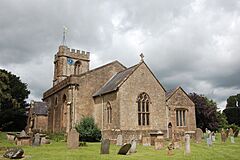Wulfric of Haselbury facts for kids
Quick facts for kids SaintWulfric |
|
|---|---|

St Michael and All Angels Church, Haselbury Plucknett
|
|
| Born | c. 1080 Compton Martin, Somerset, England |
| Died | 20 February 1154 (aged 73–74) Haselbury Plucknett, Somerset, England |
| Venerated in | Roman Catholic Church, Anglican Communion |
| Feast | 20 February |
Wulfric of Haselbury (born around 1080, died February 20, 1154) was a special kind of holy man called an anchorite. He lived a quiet life, away from the world, in Wiltshire and Somerset, England. Many people, including King Stephen, would visit him. People believed he could perform miracles. His special day is celebrated on February 20.
Contents
Who Was Wulfric of Haselbury?
Wulfric was born around 1080 in a place called Compton Martin in Somerset, England. This was about ten miles south of Bristol. He became a priest and first worked in a town called Deverill, near Warminster.
Wulfric's Change of Heart
When he was a young priest, Wulfric really enjoyed hunting. He used both hawks and dogs for this hobby. But one day, he had a conversation with a beggar. This talk changed his life. He decided to focus more on religious activities. After this, he moved back to Compton Martin to work as the local priest there.
Life as an Anchorite
In 1125, Wulfric moved to St Michael and All Angels Church in Haselbury Plucknett, Somerset. He wanted to become an anchorite. An anchorite is a person who chooses to live alone, away from the world. They live in a small room, often next to a church.
Wulfric's small room, called a cell, was on the cold north side of the church. This is where the vestry (a room for priests' robes) is now. He didn't get official permission from the church leaders for this move. However, the Cluniac monks from Montacute supported him.
Friends and Visitors
Sir William FitzWalter, a local lord, respected Wulfric very much. He sent food to Wulfric and visited him often. Wulfric also had close friends. These included Osbern, the village priest, and William, a lay brother from Forde Abbey. Another friend, Brichtric, seemed to join Wulfric as a helper or student.
Soon, people started coming to Wulfric for advice and blessings. During the time of kings Henry I and Stephen, Wulfric became very important. Not only in his local area but also at the royal court.
Wulfric's Special Abilities
People believed Wulfric had special gifts. They said he could predict the future and heal people. He told King Henry I that he would die soon, which turned out to be true. He also told King Stephen off for the bad things happening in his government. Wulfric was known for healing people's bodies, minds, and spirits.
One person who visited him was Matilda of Wareham. She had planned to work overseas. But Wulfric convinced her to become an anchorite too. She agreed and went to Wareham for over two years while a cell was built for her. She returned with her servant, Gertrude. Matilda lived in her cell for fifteen years until she died. Gertrude then took her place.
Wulfric's Daily Life
According to Abbot John of Forde Abbey, Wulfric lived alone in his simple cell for 29 years. He spent most of his time reading the Bible and praying. He followed very strict religious practices. He tried to get very little sleep. He ate simple food without meat. He spent hours saying prayers while sitting in a bath of cold water. He also wore a rough shirt made of hair and a heavy chain-mail tunic.
Wulfric's Death and Burial
Wulfric was one of the most important anchorite priests in medieval England. He died in his cell on February 20, 1154. After he died, there was a disagreement at St. Michael's Church. Black-robed Norman Cluniac monks from Montacute arrived. They argued with the local people from Haselbury and Crewkerne. Osbern, the priest of Haselbury, had called the locals.
The monks said they had provided food for Wulfric for many years. Because of this, they believed they had the right to take his body. But the local people made them leave. Wulfric was buried in his cell by the bishop of Bath, who had visited him just before he died. To keep Wulfric's remains safe, Osbern moved them twice. They finally rested somewhere near the west end of the church. Only Osbern and God knew the exact spot.
Wulfric's Legacy Today
In July 2009, a special event called The Wulfric Festival took place. It was held at the parish churches of St Michael and All Angels in Haselbury and St Martin's in North Perrott. This festival lasted for three days. It featured different kinds of music, including classical, folk, jazz, and West gallery music. All the money raised from the festival went towards helping to restore the two churches.

